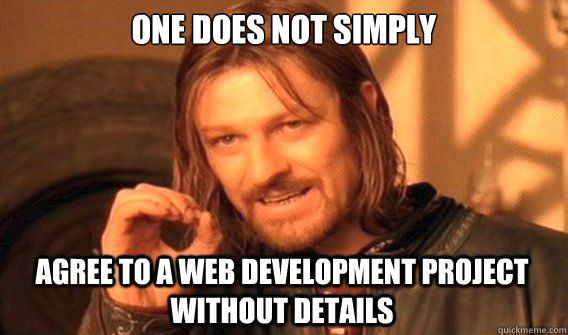It is often said that the website development process revolves around coding and only coding. I beg to differ. There are numerous steps in developing a web application. We, in this article, will step by step analyze the holistic seven-stage approach of Web development life cycle.
Get Complimentary Web Development Consultation
“If you define the problem correctly, you almost have the solution.” – Steve Jobs
You want to develop a commercial website or a web application. You hire a web development company. You let them know your requirements and they provide you with estimates. After a few months of hard work, you have an appealing website in front of your eyes which over time attracts huge web traffic and becomes a powerhouse for revenue generation. Ecstatic? You should be!
But website development is not that simple and doesn’t happen in the blink of an eye. The complete web development process is time-consuming and is a result of long hours of behind the scenes commitment by business analysts, designers, developers and testers.
If you are to hire a software development team to help you develop a web application, you should be aware of the complete process behind the application development.
Read more : 5 most common custom software development problems
In this article, we have listed down a holistic seven-stage approach of Web development life cycle.
The 7 steps of developing a website :
-
Understanding client requirements
-
Research and developing a Business requirement document
-
Planning
-
Designing
-
Development
-
Testing and Deployment
-
Maintenance
Let’s break these down point by point:
[1] Understanding client’s requirement
The most crucial part of any web development process is understanding what the client wants. All the other subsequent steps are dependant on this step. If you don’t get this step right, chances are you won’t get the software right either. Let me explain this with a story :
USER STORY –
A client comes and tells you that he needs to build some furniture. And the requirements for the piece of furniture is – It’s an item used to sit on, has two arm handles and should be comfortable.
You process the requirements and without further questioning, you present him with a chair!
The client in dismay calls out “This is not even close to what we wanted”. We wanted a couch! This is a chair!
But… it perfectly matched the requirements! So, what went wrong?
You assuming that the client requirements were discussed in entirety and not further questioning him or jotting down the requirements on pen and paper is what went wrong.
The first step of a website development process should always start with requirement gathering. The purpose of the web application, the goals, the application’s target audience – discussing all these with the client to understand the requirements are of utmost importance. Let’s understand these one by one:
[a] Purpose of developing the website should be very clear. Whether you want to promote your service, sell products online or just provide information of your online business is of crucial knowledge to a web development company.
[b] End goals are a must. What is the vision behind the website and what goals the client thinks it will achieve is important.
[c] Target audience helps in understanding the user flow. Different age cohorts will respond to different UI/UX. So, it’s important to know what group of the audience we are targeting before a product is developed.
In the initial stages of the requirement discussion, BinaryFolks sets up frequent detailed meetings with the clients to get a complete picture of the requirements. Also, keep in mind, the more fleshed out this stage will be, the more precise the cost and time estimation will be.
Read more: How to estimate software development time?
How to estimate software development costs?
[2] Drafting a Business Requirement document (BRD)
Once the requirements have been gathered at a high level, it needs to be documented. Any good business analyst always strives to gain an overall understanding of the business requirement and then translate it to a BRD that would be used as a reference for the development process.
BRD should always be precise, easy to understand and unambiguous. This is the document that developers will refer to when they will start the web application development, so, it must contain sufficient details and breakdowns wherever necessary.
This Business requirement document will be the holy grail for the software development company as well as the client. Make it a point to consider all possible deliverables and constraints.
This particular step of the website development process also helps in avoiding cost and time overruns. All development must adhere to this document and any new modifications will require extra effort, both in terms of money and time.
[3] Planning
“A goal without a plan is just a wish.”
― Antoine de Saint-Exupéry
Now that you know what exactly needs to be developed and have a detailed BRD of the same, the next phase is project planning. Before the first line of code is written, it is of utmost importance to determine the tasks and manage the allocation of resources involved in the web application development.
This phase mainly comprises of :
[a] Wireframing
[b] Defining site architecture
[c] Selecting the technical stack
[d] Milestone bifurcation
[e] Deciding on resources and estimates
The fundamental step of planning must start with wireframing and defining site architecture. One wouldn’t build a house without a blueprint, right? So, we should also not start designing or developing web applications without a wireframe and sitemap.
A Sitemap is a hierarchical list of all the website pages and it helps the development team to build on. The designers and developers get a complete picture of not only the structure but also the overall distribution of pages in the site. Without a sitemap, your site will be unorganized.
A wireframe is a way to visualize website design at the structural level and is super important to identify usability issues early on. It also helps in visualizing the complete user journey and choose appropriate UI components. This is the foundation of your website and if you don’t have a strong foundation, everything that you do on top of it will crumble.
Proper integrated planning focuses on everything required for successful completion of the project. Project planning helps in better utilization of the company’s resources and makes sure that the time allotted for each phase is used optimally.
[4] Design
A good design is not only about aesthetics, but it’s also about user interaction. The design of your website is more critical for conversions than you think.
Once the wireframing and site architecture is in place, the designers start working towards visual elements.
In this step, designers start working on the visual brand. You can actually visualize how your website will look. The layout, the screens, buttons, headers and footers, navigation, photos, videos, and other visual elements are all added in this step of the website development process.
As discussed earlier, the designers need to keep the application’s target audience in mind and design websites according to the taste and preference of the target audience.The website layout (including color, logos images etc) needs to be discussed with the client and tailor-made according to his preferences and target audience’s taste.
[5] Development
Now that we have added flesh to the skeleton, it’s time for the skeleton to function. At this stage, the developers start coding and transforms your static webpage into working software.
Get A Quote For Your Web Development Project
Software development coding has two parts :
Front end development: It is referred to as the “client-side” development. This is what users see and interact with on the browser. The user-interaction is of prime importance here.
The front end developers don’t actually design the website but they are responsible for bringing the design to life. They take the static elements and transform them into fully functioning interactive websites.
Back end development: The portion of the website that is not visible to users. The backend communicates with the front-end and sends information to and fro so that users can interact with the website features.
The backend software developers make sure that all the business logic and data storage is properly implemented. Database creation and integration, API development and integration, Security checks, etc are all part of backend development.
[6] Testing and Deployment
Any software should always be thoroughly tested before deploying it in production so that your production environment is not threatened by bugs. So, having a proper, streamlined testing process is crucial.
A web application must be thoroughly tested before making it live. Testing is basically done to make sure there are no bugs or broken links and to make sure the web application is ready for launch.
User acceptance, Beta testing, Functional and Performance Testing, White Box or Black box Testing are some of the many testing methods software development companies implement to test their work to eliminate bugs that might compromise product quality. Additionally, cross-device testing is also performed to ensure smooth operation of the application on a various devices with different screen sizes, resolutions, device types, and OS.
Once there is a go-ahead from the testers, the code is pushed to production. Make sure to meticulously re-test on production as well.
Always have a staging server backup so that if production is severely broken after deployment, they can use the backup to restore production.
At BinaryFolks, we carry out rigorous testing after every milestone. This is because, if the bugs are caught early, it is easier and less complicated to fix them rather than fixing them when the whole application is working. This considerably helps reduce software development costs too.
[7] Maintenance
The web development process doesn’t end with deployment. Software maintenance has a huge role to play in the complete web development process.
The purpose of software maintenance is modifying and updating software applications to correct bugs, enhance capacity and add features to improve the performance of the system.
Any updates, modifications, bug fixes, patches and developing additional features in order to increase the performance of existing software is incorporated in software maintenance.
Ensure that if anything comes up, your software team fixes it right away. Any wrong information or outdated content leads to loss of potential client. BinaryFolks offer 90 days free bug support.
Conclusion
Finally, always keep in mind that coding is not the only integral part of web development. The web development process is divided into steps and every step is crucial for the success of a project. BinaryFolks adheres to all these steps and ensures at the end of the day, there are absolutely no negative surprises for our clients when times come for delivery. Take a look at our complete stages of website development here.
If you want to develop a web application and need to hire a Web developer, jump into a call with us for a quick consultation.
Get Started With Web Development
FAQs
The website development process is divided into 5 major steps, these include
- 1. Planning: in this step, you define the project scope and decide the overall features and functionalities you are going to add to your website.
- 2. Design: here you finalize the design of the website, giving your clients an opportunity to make any last-moment changes if necessary.
- 3. Development: with everything decided the idea is finally converted into a fully operational website with all the required features.
- 4. Testing: the website is rigorously tested for any issues before it is pushed to production, and any detected bugs or errors are promptly fixed.
- 5. Launch: the website is finally launched to the intended user base, you can ask your service provider for post-development services like maintenance and upgrades.
Web development services are divided into 3 types, and they are –
- 1. Front-End Development – this is focused on improving the user interface and the user experience of the website. Some commonly used tools to achieve this include – HTML, Javascript, and CSS.
- 2. Back-End Development – here the logic and functionality of the website are created and managed. It is developed using programming languages like Python, PHP, Ruby, and Node.js.
- 3. Full Stack Development – this web development method encompasses both the previously mentioned methods in one, which means a full stack development service includes the front-end development as well as the back-end development.
It is difficult to predict the exact time required for building a website from scratch as it largely depends on the complexity and extra integrations you wish to add to the solution. However, on average a simple web development process can take a few months, whereas a complex website development project with multiple third-party integrations and extra features can take multiple months to a year to finish.
Depending on the complexity of the website you are trying to develop the cost of development can be classified into 3 categories:
- 1. Simple Websites: These websites are built with minimal features and functionalities so the cost of these types of websites can be anywhere between $500-$5000.
- 2. Semi-Complex Websites: These websites have relatively more features and the architecture is a bit more complex, which puts them somewhere in the price range of $5000-$20000.
- 3. Complex Websites: These websites have an extremely complicated architecture with separate logical flows working collectively, these solutions can easily cost anywhere between $20000-$100000, or beyond.






